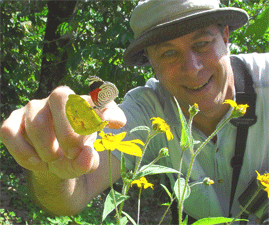 | ||
Organization founded North American Butterfly Association Books Butterflies through binoculars, A Swift Guide to the Butter, Caterpillars in the Field and Gard, A Swift Guide to Butterflies, Birds of North America | ||
Jeffrey Glassberg is an American biologist who founded the North American Butterfly Association (NABA) and is the leading proponent of moving interest in butterflies from hobbyist collecting and nets to butterflying with binoculars and cameras.
Contents
Early life
Jeffrey Glassberg was born in Brooklyn, New York, on November 27, 1947, where his family lived until 1952 when they moved to Long Island, New York. His father established his own company making automobile seat covers and his mother worked there as well. Glassberg's early years were devoted to nature; bird-watching, chasing butterflies, and, with his younger brother, to chemistry experimentation. Moving from the buildings of New York City to a place of forests and meadows on Long Island where his parents allowed him to roam stimulated his interest and love of nature which continues.
Family life
Jeffrey Glassberg met his future wife, Jane Scott, in a seminar course on bacteriophage lamda at Rice University. When he moved to Stanford University School of Medicine in 1972, she accompanied him and was a post-doctoral fellow at the University of California, San Francisco. In 1979 they both moved to Rockefeller University, where she worked on virology in the laboratory of Purnell W. Choppin.
Education and academic career
Glassberg graduated from Tufts University School of Engineering with a degree in civil engineering in 1969, but turned to biology after travels to South America with a colleague to study butterflies. He took summer biology courses and taught high school biology on the North Shore of Long Island, before acceptance into the graduate program at Rice University, Houston, Texas, in 1972. Glassberg received his PhD in biology from Rice University in 1977, working on the genetics of bacteriophage SP01 DNA replication in the laboratory of Charlie Stewart. He then spent three years in the Biochemistry Department at the Stanford University School of Medicine where he was a post-doctoral fellow in Arthur Kornberg's laboratory doing research on DNA-binding proteins. Glassberg moved to Rockefeller University, New York City in 1979 and worked on creating a genetic system using the eukaryote, Crithidia fasciculata, a trypanosomatid parasite of mosquitos.
Conservation with butterflies
Glassberg obtained a Doctorate of Jurisprudence (J.D.) from Columbia University School of Law in 1993 and is an adjunct professor in the Department of BioSciences at Rice University.
In November 1992, Glassberg founded the North American Butterfly Association to engage the public in the support of conservation.
Field guides
He is the author of seven butterfly field guides that use photographs of live butterflies, in addition to initiating and editing a field guide to dragonflies and one to wildflowers.
Glassberg was the first to write a butterfly field guide intended for readers to identify butterflies using binoculars. "His new book, Butterflies Through Binoculars: A Field Guide to Butterflies in the Boston-New York-Washington Region, published this year by Oxford University Press, is the first to focus on netless butterflying." "His own Butterflies through Binoculars, published in 1993, is credited with revolutionizing the pursuit of butterflies with its emphasis on observation in the field".
In 1999, Robert Robbins, then chair of the Department of Entomology at the Smithsonian Institution’s National Museum of Natural History, stated that "Glassberg’s butterfly guides have provided a new way for amateur naturalists to identify species without collecting them or dissecting them. Previously, he said, butterfly books distinguished between species using technical, almost microscopic details. But in Mr. Glassberg’s years of field observation, Dr. Robbins said, he has found variations in the way butterflies appear that allow species – or the sex of individuals of a species – to be distinguished simply by looking. The option of just watching butterflies and understanding what you’re seeing just wasn’t there before".
Glassberg's 2001 book, Butterflies Through Binoculars: The West received first place in the nature guidebook category of the 2001 National Outdoor Book Awards.
Books
____ As sole author:
___ As co-author:
___ As editor:
